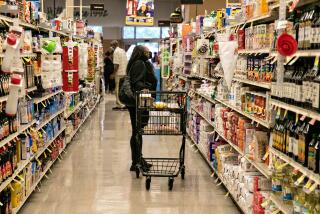Access to grocers doesn’t improve diets, study finds
- Share via
Better access to supermarkets — long touted as a way to curb obesity in low-income neighborhoods — doesn’t improve people’s diets, according to new research. The study, which tracked thousands of people in several large cities for 15 years, found that people didn’t eat more fruits and vegetables when they had supermarkets available in their neighborhoods.
Instead, income — and proximity to fast-food restaurants — were the strongest factors in food choice.
The results throw some cold water on the idea that lack of access to fresh produce and other healthful foods is a major driver in the disproportionate rates of obesity among the poor, or that simply encouraging grocery chains to open in deprived areas will fix the problem, said study lead author Barry Popkin, director of the Nutrition Transition Program at the University of North Carolina in Chapel Hill.
For one thing, experts said, grocery stores are brimming with choices that are every bit as fattening as fast-food meals. For another, the prices of healthful grocery store foods are often higher than fast-food prices.
“This raises the serious issue of how we get people to eat healthy,” Popkin said.
The study, published last week in the Archives of Internal Medicine, looked at more than 5,000 African American and Caucasian men and women in Birmingham, Ala., Chicago, Minneapolis and Oakland between 1985 and 2001. The researchers assessed participants’ diets over the years and tracked how far they lived from supermarkets and fast-food restaurants. The study did not measure their weight or body mass index.
As other studies have reported, the researchers found that living near fast-food restaurants was associated with a greater consumption of fast food, especially, in this case, among low-income men. But the scientists also found that easy access to supermarkets was not linked to a greater consumption of healthful foods such as fruits and vegetables, low-fat dairy products, lean meats and whole grains.
Other studies, Popkin said, had found the same thing. In one, the introduction of a large supermarket did not increase fruit and vegetable consumption in a poor community in Scotland; in another, a 2011 survey of Latino immigrant women in New York City found no relationship between supermarket proximity and eating more fruits and vegetables.
“The cheapest calories come from fried foods, chips and sodas,” said Dr. Jonathan Fielding, director of the Los Angeles County Department of Public Health, who wrote a commentary accompanying the report.
The findings are significant because in recent years, policymakers have been pushing for guidelines that limit the number of fast-food restaurants in low-income neighborhoods based on studies reporting lower obesity rates in communities with more supermarkets and fewer fast-food chains.
In 2008, for example, Los Angeles Councilwoman Jan Perry sponsored legislation calling for a moratorium on new fast-food restaurants, and for incentives for opening grocery stores, in South L.A. Though the moratorium has expired, some restrictions on where fast-food restaurants may open are still in place.
“We’ve had great success in building grocery stores,” Perry said. But, she added, selecting healthful foods from a store is up to the individual.
J. Justin Wilson, senior research analyst for the Center for Consumer Freedom, a Washington, D.C.-based organization funded by the restaurant industry, said that such measures had an “anti-corporate whiff” and that this study showed that government meddling is not the answer.
“Trying to change the market doesn’t necessarily work and at the same time undermines personal responsibility,” he said.
But not all grocery stores are created equal, said Frank Tamborello of Hunger Action Los Angeles, a group that promotes better diets. Supermarkets in underprivileged areas often offer fewer, lower-quality and more expensive healthful food options than stores in better-off neighborhoods, he said.
Obesity experts also stressed that measures to improve the food environment were important — they can’t happen just in a vacuum. What’s needed, said, Gwen Flynn, director of community health and education at Community Health Councils in Los Angeles, is “a comprehensive plan to change what people are eating,” including community education and government and private subsidies for healthful foods.
Some programs already exist, such as SNAP-Ed and the Expanded Food and Nutrition Education Program, sponsored by the U.S. Department of Agriculture, which provide nutrition education to families eligible for food stamps. Programs teaching low-income families how to grow vegetables also are on the uptick.
And in October 2009, the Special Supplemental Nutrition Program for Women, Infants and Children began providing year-round cash vouchers for fruits and vegetables. A 2010 study found that educating participants was key in nudging them to improve their eating habits.
Celebrity chef Jamie Oliver, an outspoken advocate of healthful eating, said in an email that shopping at supermarkets did not automatically translate to good choices.
“If you go into most grocery stores across America, the majority of the store is chock-full of processed food calling out to you from the packages, ‘Pick me! I’m tastier and more convenient,’” Oliver wrote. “And ringed around all this are good old veggies, with no instructions.”






